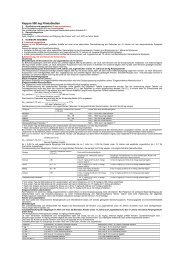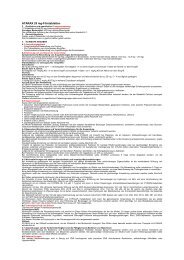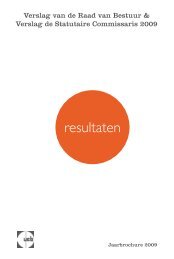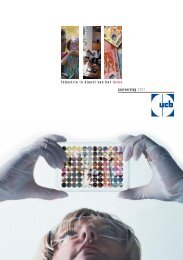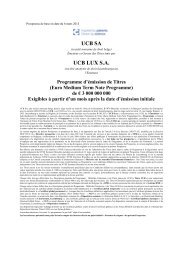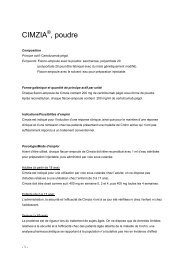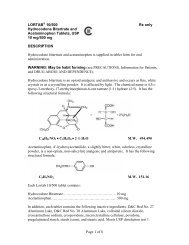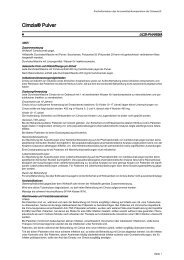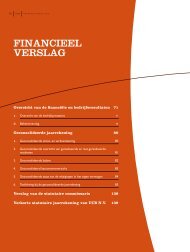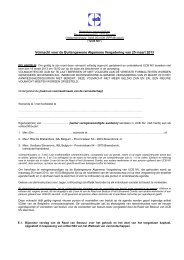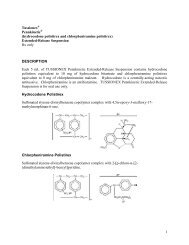UCB SA - BNP Paribas Fortis
UCB SA - BNP Paribas Fortis
UCB SA - BNP Paribas Fortis
You also want an ePaper? Increase the reach of your titles
YUMPU automatically turns print PDFs into web optimized ePapers that Google loves.
assisted drug discovery (“CADD”), a technology which assists and facilitates drug discovery<br />
programmes through the application of advanced modelling, simulation and data visualisation<br />
techniques, and protein crystallography, a technology which provides structural information on<br />
compound binding to research targets.<br />
NBE Technologies<br />
<strong>UCB</strong>’s proprietary selected lymphocyte antibody method (“SLAM”) technology enables the Issuer to<br />
isolate rare, high-affinity, functionally-active antibodies with speed and precision, reducing the time it<br />
takes to identify these antibodies from six months to approximately eight weeks. The development of<br />
this licensed technology has enabled <strong>UCB</strong> to identify such antibodies and to develop them for specific<br />
requirements from a wide range of species. The <strong>UCB</strong> Group is constantly endeavouring to improve<br />
SLAM, with the PEGylated antibody fragment platform giving the <strong>UCB</strong> Group a further edge by<br />
enabling it to prolong the therapeutic activity of the fragment of antibody, leading to less frequent, more<br />
convenient dosing.<br />
(c) Therapeutic Focus: Research Areas<br />
In accordance with its general strategy, the research and development activities of the <strong>UCB</strong> Group are<br />
focused on the therapeutic areas of severe CNS and immunology disorders.<br />
Central Nervous System<br />
The <strong>UCB</strong> Group has an established record of innovative CNS research and has developed a number of<br />
novel, marketed drugs and continues to strive for new treatments of neurological disorders such as<br />
epilepsy, diabetic neuropathic pain, Parkinson’s disease and other movement disorders as well as<br />
diseases involving cognitive impairment. The research strategy of the <strong>UCB</strong> Group in the therapeutic<br />
field of CNS is to combine target-based drug discovery with a focus on target validation in diseaserelevant<br />
neuropharmacology models of integrative brain activity. The <strong>UCB</strong> Group’s research focuses<br />
on neural excitability as a whole because the <strong>UCB</strong> Group considers that abnormalities in neural<br />
excitability and synchronization underlie many neurological conditions.<br />
The <strong>UCB</strong> Group established a leading scientific platform for the therapy and treatment of epilepsy with<br />
the development and production of Keppra®, followed by the approval of Vimpat® in 2008. Clinical<br />
trials for Keppra®XR in the U.S. for monotherapy use are ongoing, with results expected later in 2009.<br />
The <strong>UCB</strong> Group is continuing to develop new molecules for the treatment of epilepsy, with Phase III<br />
results of brivaracetam currently being analysed. Brivaracetam is a broad-spectrum anti-epileptic<br />
product in development which has a distinct pharmacological profile that distinguishes it from other<br />
currently available treatment options, demonstrating a 10-fold higher affinity for synaptic vesicle<br />
protein 2A (SV2A) than Keppra®. The clinical significance of these findings is not known.<br />
Brivaracetam also demonstrated inhibitory activity at neuronal voltage-dependent sodium channels<br />
whose abnormal function is understood to contribute to electrical discharges associated with seizures.<br />
These differences may be important for the antiepileptic activity of brivaracetam, its clinical efficacy<br />
and its tolerability. Brivaracetam is protected by a composition of matter patent until 2021.<br />
Vimpat® is in development as a diabetic neuropathic pain treatment in both the U.S. and the EU. A<br />
new Phase III trial design is being proposed for further testing in 2009. Separately, testing continues in<br />
relation to the use of Vimpat® as a monotherapy for epilepsy in the U.S., where the Phase III trial is<br />
A11250830/2.25/23 Oct 2009 68



